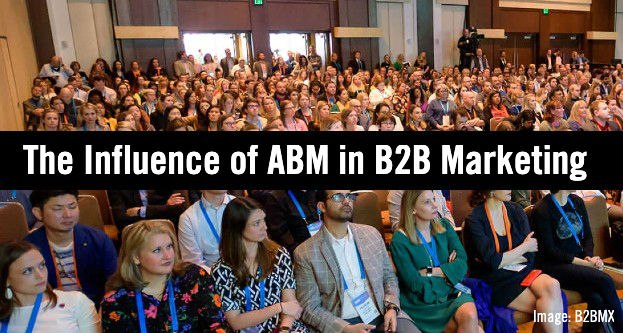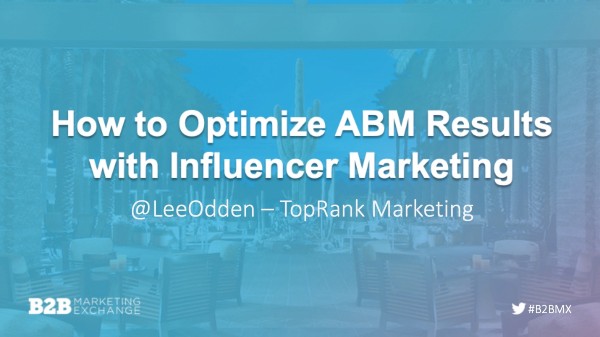http://feedproxy.google.com/~r/OnlineMarketingSEOBlog/~3/EPKfWXUNfJs/


2020 marks the 8th year in a row that I’ve presented at the B2B Marketing Exchange. During that time there have been many changes: within the B2B marketing industry, the strategies and technologies driving performance and in the programming at B2B events like B2BMX.
ABM in particular has experienced a rise in the B2B marketing world and evidence of that momentum is evident in the session topics, martech vendors and attendees at this year’s B2BMX conference in Scottsdale, February 24-26.
According to research from Demand Gen Report, 50% of B2B companies have been implementing ABM programs for more than a year and that number will continue to rise. With growing popularity, increasing numbers of marketers are searching for ways to incorporate ABM into their B2B marketing mix.
Enthusiasm around ABM has reached B2BMX in the form of numerous sessions in the program dedicated to the practice. It’s easy to see why as B2BMX Content Director, Andrew Gaffney puts it:
“ABM has transformed B2B marketing at a foundational level and has helped usher in more contextual and relevant outreach across all mediums.” @agaffney
To get a handle on where ABM is going and what B2B marketers should be focusing on in 2020, I spoke with several B2BMX speakers that will be presenting on ABM and asked for their insights.
“While traditional demand generation activities continue to be the lifeblood of marketing-sourced pipeline for B2B revenue marketers, ABM is now becoming the conduit for the historically strained relationship between marketing and sales. ABM requires marketers and sales teams to work together on things like account selection, personified value propositions and success measures – ultimately uniting teams prior to GTM, reducing revenue attribution friction and creating camaraderie. When building your ABM strategy, engage your extended teams early, gain their buy-in, ideas, and suggestions and build on the qualitative gains.”

Stacy Gardner /in/stacyrambingardner
Director of Marketing Programs, Banking Solutions at Bottomline Technologies
“One of the most significant challenges B2B marketers are facing is how to achieve any degree of scale to their ABM efforts. As sales increasingly sees the value of an account-based approach, the pressure falls on marketers to deliver on the promise of ABM but to an expanded list of accounts. In 2020, successful ABM leaders will be those that make compelling arguments internally to secure or re-allocate more resources to support the accounts that matter most.”

Bob Peterson /in/bob-peterson
Vice President, Principal Analyst, Account-Based Marketing for the SiriusDecisions at Forrester Research
“No forms, no cold calls and no spam in 2020 – As a marketer, your cold emails are probably not getting you any business but are definitely getting you unsubscribes. To break out from the noise, marketers will personalize for the account, persona and buying team, behavior and TIMING. Next year, marketers will break up with the form fill, the spam email and the cold call. Rather than bombard buyers with irrelevant emails, marketing teams will take a leap to understand what they care about. Marketing will generate bigger deals and win more often by uncovering, prioritizing and engaging in-market buyers.”

Latané Conant @LataneConant
Chief Marketing Officer at 6sense
“Since 2020 marks a new decade, let’s start fresh. Many b2b marketers are hamstrung by old-style expectations of what they can do. Starting now, marketing leaders in account-centric models (i.e. everyone in b2b) must re-negotiate terms of how they’re measured. Reality in a world where more revenue comes from keeping and growing accounts you have means success based on marketing-sourced leads is largely irrelevant. Look instead at the holistic view of how marketing engages and encourages customers. Measure marketing based on engagement, revenue and retention but in context of overall customer experience, not just top of the old funnel.”

Megan Heuer @megheuer
Vice President of Marketing at Engagio
With any newish marketing discipline on the rise, it’s tempting to think of ABM as a flashy new B2B marketing strategy, but experienced marketers like Sangram Vajre, CEO at Terminus sum it up succinctly, “ABM is B2B”.
With such a broad view of ABM, it’s inevitable to see the connections between ABM and other B2B marketing disciplines that effective at creating real marketing and business impact.
One of those intersections is between ABM and influencer marketing as Nick Nelson has covered here recently:
“The intersection of ABM and influencer marketing represents one of the most promising frontiers for B2B marketing, especially when it comes to the pursuit of enterprise customers. Not only do influencer partnerships help you break through and gain visibility with busy decision makers at these coveted accounts, but also drive engagement and persuasively move the needle.”
In my own journey to understand the opportunities with ABM, I’ve learned that within ABM, the focus on influencers has to do with individuals that influence within buying committees. But what about the source of influence for those buying committee influencers? The role of influence is certainly not limited to those within the target account.
The question I’ll be posing in my B2BMX presentation, is why limit our focus on influencers to those within the target account?
Who is influencing the influencers and how can we activate them to improve our B2B marketing?
Understanding the sources of influence for individuals within a target account can provide essential insights into the signals, targeting and content activations that can make ABM work even better.

In my presentation, How to Optimize ABM Results with Influencer Marketing, I’ll be digging in to how B2B marketers can identify those influencers, how to map topics of influence to content activations with influencers and examples of how ongoing influencer engagement can create brand awareness, advocacy and influence within accounts.
If you’re attending B2BMX this week, you may see my TopRank Marketing associates Susan Misukanis and Joshua Nite attending sessions and interviewing key B2B marketing influencers.
Here are a few sessions on ABM and in other areas that our team is looking forward to:
Monday Case Studies – 2:20PM
Dell Technologies And Innovative Conversion Strategies That Create Pipeline
Anamaria Alba, Dell Technologies
Ed Grossman, Activate
Monday Case Studies – 3:10PM
From ABM Zero To Revenue Hero In Less Than A Year: How One Marketer Won Over Sales & Delivered Success — Fast
Katie Findling, Smarsh
Brian Panicko, Smarsh
Megan Heuer, Engagio
Monday 4:05PM Keynote
Getting The Green Light: How To Build Messages People Say YES To
Tamsen Webster, Find The Red Thread
Monday 5:30PM
Killer Content Awards Ceremony
TopRank Marketing is proud to share two of our clients are KCA finalists!
Dell Outlet Small Business and Alcatel Lucent Enterprise
Tuesday 10:45AM
ABM And Demand Generation: Taking A Blended Approach
Robert Peterson, SiriusDecisions
Tuesday LUNCH & LEARN: 12:20PM
Experiences Everywhere: How To Create Marketing Your Audience Demands
Mark Bornstein, ON24
Tuesday 4:30PM
Move Over Mediocre! The B2B Marketer’s Journey To Experiential Content
Ryan Brown, Ceros
Darius Eslami, Carbon Black
Paige Gildner, Bluecore
Sharon Shapiro, Bluecore
Wednesday 10:40AM
How To Optimize ABM Results With Influencer Marketing
Lee Odden, TopRank Marketing
Wednesday 11:20AM
PANEL: Orchestrating ABM With Channel Partners
Latane Conant, 6Sense
Rauli Garcia, Sage Intacct
Kerry Desberg, Impartner
Jessica Garrett, KORE Wireless (former)
Wednesday 2:15PM
ABM, DemandGen, Hybrid: Best-Practice Tips & Tricks To Improve Conversion
Jon Russo, B2B Fusion
Tim White, People.ai
Corey Livingston, OneNeck IT Solutions
Neenu Sharma, GE Digital
Stacy Gardner, Bottomline Technologies
Wednesday 3:30PM
The B2B Marketing Team of Tomorrow: The Top Skills & Talents Shaping Success For The New Decade
Wes Lieser, Versique
Rose Spicer, Oracle
Michelle Liro, PTC
Nirosha Methananda, Bombora
Be sure to follow our liveblogging of B2BMX here on TopRank’s Online Marketing Blog as well as our social shares on Twitter from @nitewrites, @smisukanis, @leeodden and @toprank.
To learn more about the intersection of ABM and Influencer Marketing, you can get more details on my session here:
How to Optimize ABM Results with Influencer Marketing
Wednesday, February 26th at 10:40AM
Demand Gen Summit Track – Arizona 5
Focusing on accounts with the biggest revenue potential requires every competitive advantage. But ABM alone is not enough to break through to distracted and distrustful decision makers. To connect with accounts more effectively, B2B marketers are increasingly adopting influencer marketing to build trust, reach and engagement.
This presentation with Lee Odden of TopRank Marketing will share how B2B marketers can identify the influencers that resonate most with target account contacts as well as create greater influence amongst client facing contacts. In this session you will learn:
* How an ABM and influencer marketing integration model inspires strategy
* How to determine what topics and content resonate with your target accounts
* How to identify who is influential to the people within your targeted accounts
* How to grow influence for sales and the brand
We hope to see you there!
The post The Influence of ABM in B2B Marketing: Top B2BMX Sessions & Speaker Insights appeared first on Online Marketing Blog – TopRank®.






